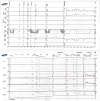Sacral neuromodulation for Organophosphate-induced delayed neuropathy neurogenic lower urinary tract dysfunction: a case report
- PMID: 39367402
- PMCID: PMC11451249
- DOI: 10.1186/s12894-024-01600-x
Sacral neuromodulation for Organophosphate-induced delayed neuropathy neurogenic lower urinary tract dysfunction: a case report
Abstract
Background: Organophosphate-Induced Delayed Neuropathy (OPIDN) is a rare neurological disorder triggered by exposure to organophosphorus compounds. These compounds exert their neurotoxic effects by impacting the nervous system, leading to systemic manifestations. Urinary system symptoms are infrequently observed in clinical settings. Currently, effective therapeutic interventions for OPIDN-related urinary symptoms are lacking. Sacral nerve modulation therapy, an FDA-approved approach for managing lower urinary tract symptoms, presents as a promising option. Herein, we present a case of OPIDN-induced lower urinary tract obstruction successfully treated with sacral nerve modulation therapy, resulting in substantial symptom relief.
Case report: A 27-year-old male patient presented with severe bilateral hydronephrosis, attributed to low bladder compliance and accompanied by a fever persisting for 6 days. The patient's medical history revealed accidental ingestion of organophosphate pesticide (Dimethoate) with no concomitant underlying diseases. In consideration of the potential for OPIDN, surgical intervention in the form of sacral neuromodulation (phase I) was undertaken. Subsequent evaluation one month post-surgery revealed notable improvements in both bladder compliance and bilateral hydronephrosis, necessitating sacral neuromodulation (phase II). Presently, following a 5-month follow-up period, the patient remains asymptomatic and in favorable health.
Conclusion: This patient achieved long-term relief using sacral neuromodulation.
Keywords: Neurogenic bladder; Organophosphate-induced delayed neuropathy (OPIDN); Organophosphorus compounds; Peripheral nerve axons; Sacral neuromodulation.
© 2024. The Author(s).
Conflict of interest statement
The authors declare no competing interests.
Figures





Similar articles
-
Sacral neuromodulation in congenital lumbo-sacral and traumatic spinal cord defects with neurogenic lower urinary tract symptoms: a single-center experience in children and adolescents.World J Urol. 2019 Dec;37(12):2775-2783. doi: 10.1007/s00345-019-02721-x. Epub 2019 Mar 12. World J Urol. 2019. PMID: 30864008
-
Sacral neuromodulation with an implantable pulse generator in children with lower urinary tract symptoms: 15-year experience.J Urol. 2012 Oct;188(4):1313-7. doi: 10.1016/j.juro.2012.06.039. Epub 2012 Aug 16. J Urol. 2012. PMID: 22902022
-
Protocol for a randomized, placebo-controlled, double-blind clinical trial investigating sacral neuromodulation for neurogenic lower urinary tract dysfunction.BMC Urol. 2014 Aug 13;14:65. doi: 10.1186/1471-2490-14-65. BMC Urol. 2014. PMID: 25123172 Free PMC article. Clinical Trial.
-
Sacral neuromodulation for lower urinary tract dysfunction.World J Urol. 2012 Aug;30(4):445-50. doi: 10.1007/s00345-011-0780-2. Epub 2011 Oct 12. World J Urol. 2012. PMID: 21989816 Review.
-
Peripheral and Sacral Neuromodulation in the Treatment of Neurogenic Lower Urinary Tract Dysfunction.Urol Clin North Am. 2017 Aug;44(3):453-461. doi: 10.1016/j.ucl.2017.04.011. Urol Clin North Am. 2017. PMID: 28716325 Review.
References
-
- Pannu AK, Bhalla A, Vishnu RI, Dhibar DP, Sharma N, Vijayvergiya R. Organophosphate induced delayed neuropathy after an acute cholinergic crisis in self-poisoning. Clin Toxicol (Phila Pa). 2021;59:488–92. - PubMed
Publication types
MeSH terms
LinkOut - more resources
Full Text Sources
Medical

